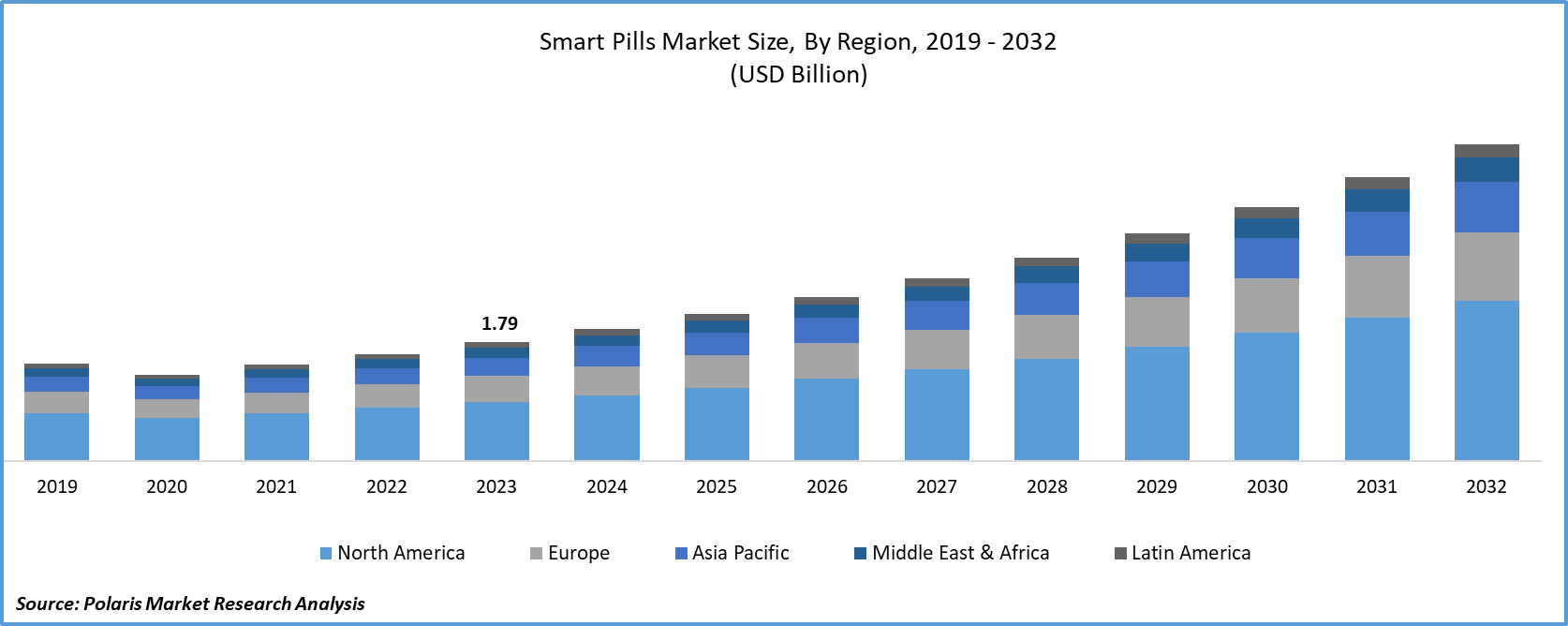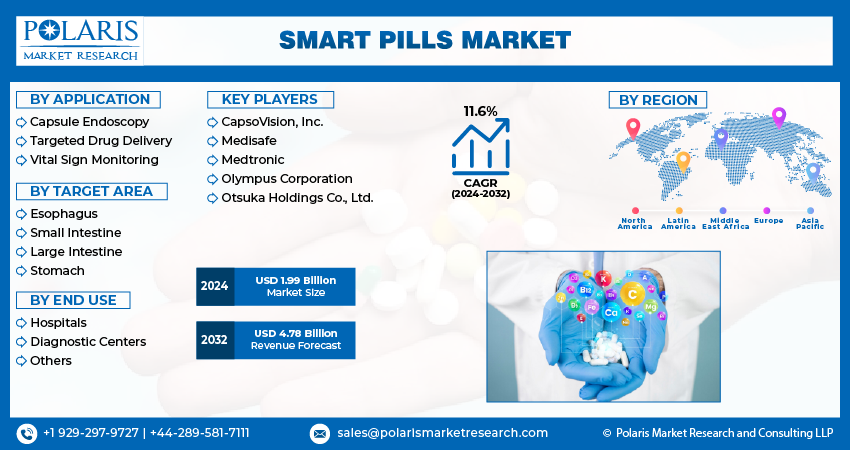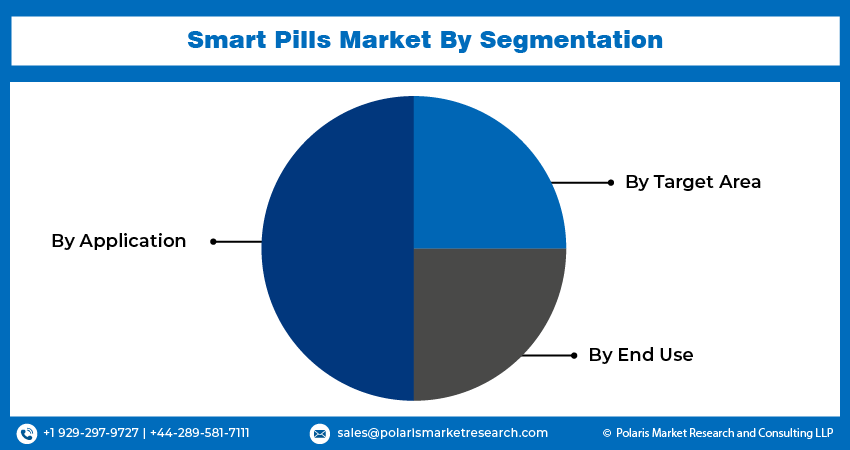
Smart Pills Market Share, Size, Trends, Industry Analysis Report, By Application (Capsule Endoscopy, Targeted Drug Delivery, Vital Sign Monitoring, By Target Area, By End Use, By Region, And Segment Forecasts, 2024 - 2032
- Published Date:Jan-2024
- Pages: 118
- Format: PDF
- Report ID: PM4154
- Base Year: 2023
- Historical Data: 2019-2022
Report Outlook
The global smart pills market was valued at USD 1.79 billion in 2023 and is expected to grow at a CAGR of 11.6% during the forecast period.
The burgeoning demand for minimally invasive procedures, a heightened focus on enhancing patient convenience, and technological advancements, including the miniaturization of integrated circuits, are anticipated to propel the growth of the market.

To Understand More About this Research: Request a Free Sample Report
As per data from the National Center for Biotechnology Information (NCBI), the United States experienced a substantial 50% surge in the number of minimally invasive procedures conducted over an 18-year period, spanning from 2000 to 2018. In 2018 alone, the country witnessed an impressive total of over 15 million minimally invasive procedures, with laparoscopic cholecystectomy (gallbladder removal), appendectomy, & hernia repair emerging as the most common among them. The increasing popularity of these minimally invasive techniques can be attributed to their manifold advantages over traditional open surgery.
As per the National Center for Biotechnology Information (NCBI), the United States is anticipated to undergo a significant demographic shift in the coming decades. The population of individuals aged 50 & older is expected to witness a substantial increase of 61.1%, rising from 137.2 Mn in 2020 to 221.1 Mn by 2050. This demographic trend is accompanied by a concerning rise in the prevalence of chronic diseases. The number of individuals aged 50 years with at least 1 medical condition will rise to grow by nearly, 99.5%, reaching 142.7 Mn by 2050, compared to 71.5 Mn in 2020
Additionally, the burden of multimorbidity, characterized by having two or more chronic diseases, is also expected to escalate significantly. Individuals with multi-morbidity are estimated to increase by 91.2%, from 7.8 Mn in 2020 to 14.9 Mn in 2050.
Potential customers for smart pills encompass individuals with paralysis, immobile patients, and the geriatric population. The increasing geriatric population is expected to drive the demand for advanced medical devices that enhance patient convenience. Furthermore, analysts forecast a continuous increase in the global population, anticipating the addition of nearly 2 billion people over the next three decades. This trajectory is expected to elevate the current population of 8 billion to 9.7 billion by 2050, with the potential of reaching a peak of approximately 10.4 billion around the mid-2080s. This growth in population presents both challenges and opportunities for sustainability, resource management, and global development in the years to come.
The market for smart pills is being propelled by the increasing demand for advanced drug delivery systems that offer benefits such as optimal utilization of active pharmaceutical ingredients, reduced dosage frequency, minimal adverse/side effects, targeted drug delivery, and safer carriers. The integration of innovative drugs, medical devices, and advanced technologies is anticipated to be a key factor in driving further smart pills market growth over the forecast period. Advanced drug delivery products are expected to find a substantial customer base among patients with chronic diseases who require precise medication dosing at the targeted site.

For More Details, Request for Report Discount
Growth Drivers
The Increased Demand for Minimally Invasive Surgical Procedures
The increased demand for minimally invasive surgical procedures has paved the way for innovative techniques like capsule endoscopy. Unlike traditional endoscopy methods that involve the use of a flexible tube, capsule endoscopy offers several advantages. One key advantage is the ease of administration, as patients can simply swallow a small capsule containing a tiny camera. This eliminates the need for invasive procedures, such as inserting a tube through the mouth or rectum.
This non-invasive approach enhances patient comfort, reduces the risk of complications, and improves the overall diagnostic process. Consequently, the advancements in capsule endoscopy are anticipated to contribute to the gradual replacement of traditional endoscopy methods in certain clinical scenarios.
Report Segmentation
The market is primarily segmented based on application, target area, end use, and region.
|
By Application |
By Target Area |
By End Use |
By Region |
|
|
|
|

To Understand the Scope of this Report: Speak to Analyst
By Application Analysis
Capsule Endoscopy Segment Held the Largest Share
Capsule endoscopy segment held the largest share. This dominance is primarily due to rising global incidence of gastrointestinal disorders, including colon cancer, Crohn's disease, and ulcerative colitis. This increase in prevalence is fueling the demand for minimally invasive diagnostic procedures, such as capsule endoscopy. According to the Crohn's & Colitis Foundation, in the United States, approximately 1 in 100 individuals is affected by inflammatory bowel disease (IBD), which comprises a group of chronic gastrointestinal disorders.
Crohn's disease, classified under the umbrella of inflammatory bowel disease (IBD), affects both men and women equally and can manifest at any age. However, it is most frequently diagnosed in adolescents and young adults, typically between the ages of 20 and 30. Research indicates a genetic predisposition to the development of IBD, with studies revealing that between 1.5 percent and 28 percent of individuals with IBD have a close family member (parent, child, or sibling) who also suffers from one of these diseases.
As per information from the National Center for Biotechnology Information (NCBI), in 2019, digestive diseases accounted for approximately 2,276.3 million prevalent cases, resulting in 2.5 million deaths and 88.9 million Disability-Adjusted Life Years (DALYs) globally. These figures represented a notable increase of 67.8% in cases, 37.8% in deaths, and 23.47% in DALYs compared to the data from 1990. Furthermore, the instances of digestive diseases saw a rise from 254.2 million in 1990 to 443.5 million in 2019.
Regional Insights
North America Region Held the Largest Share of the Global Market in 2023
The North America region dominated the market. This dominance is expected to persist throughout the forecast period, driven by factors like technological advancements in healthcare, a rise in colorectal cancer cases, and regulatory approvals for new products. According to the World Health Organization (WHO), colorectal cancer ranks as the third most common cancer globally, constituting approximately 10% of all cancer cases. Furthermore, it stands as the second leading cause of cancer-related deaths on a global scale. The demographic most affected by colorectal cancer is individuals aged 50 and above.
The Asia Pacific region projected to grow at the rapid pace. Region’s growth is due to mandatory healthcare insurance, technological advancements, and a growing prevalence of stomach cancer and gastrointestinal disorders. In 2020, global reported cases of gastric cancer exceeded 1 million, leading to 769,000 deaths. Some Asian countries, including Japan, Mongolia, & China, exhibit higher incidence rates. Despite an overall decline in gastric cancer incidence, there is a troubling increase in cases among young adults over the past few decades.

Key Market Players & Competitive Insights
Market leaders are implementing various growth strategies, including mergers and acquisitions, enhancements to existing devices, promotional initiatives, and technological advancements. For instance, introduction of Semaglutide, an anti-diabetes pill by the Novo Nordisk, in 2022 in India. This launch offers a new treatment option for individuals managing type 2 diabetes.Top of Form
Some of the major players operating in the global market include:
- CapsoVision, Inc.
- Medisafe
- Medtronic
- Olympus Corporation
- Otsuka Holdings Co., Ltd.
Recent Developments
- In April 2023, Apollo introduced the Da Vinci Xi Robotic Surgical System, featuring state-of-the-art technology and advancements in surgical procedures. This system is designed to enable minimally invasive surgeries, involving small incisions, leading to reduced patient trauma, less pain, and faster recovery compared to traditional open surgeries. The advanced technology of the Da Vinci Xi system contributes to improved surgical outcomes.
Smart Pill Market Report Scope
|
Report Attributes |
Details |
|
Market size value in 2024 |
USD 1.99 billion |
|
Revenue forecast in 2032 |
USD 4.78 billion |
|
CAGR |
11.6% from 2024 – 2032 |
|
Base year |
2023 |
|
Historical data |
2019 – 2022 |
|
Forecast period |
2024 – 2032 |
|
Quantitative units |
Revenue in USD billion and CAGR from 2024 to 2032 |
|
Segments covered |
By Material, Product Type, By Straw Length, Diameter, Sales Channel, End Use, By Region |
|
Regional scope |
North America, Europe, Asia Pacific, Latin America, Middle East & Africa |
|
Customization |
Report customization as per your requirements with respect to countries, region, and segmentation. |
FAQ's
The smart pills market report covering key segments are application, target area, end use, and region.
Smart Pill Market Size Worth $4.78 Billion By 2032
The global smart pills market is expected to grow at a CAGR of 11.6% during the forecast period.
North America is leading the global market
key driving factors in smart pills market are Growing Geriatric Population.
